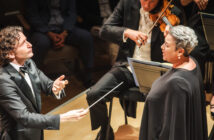by Paul E. Robinson
George Szell: A Life in Music
by Michael Charry
Urbana: University of Illinois Press, 2011412 pages
One of the conducting icons of my youth was George Szell. I had the good fortune to live within a few hundred miles of his home base in Cleveland and regularly heard Szell with his great orchestra in Cleveland, Toronto and at an annual Spring festival in London, Ontario. Many of Szell’s finest recordings come from this period. I idolized the man for his ability to galvanize an orchestra – whether through musicianship, by force of personality or fear, I wasn’t sure which at the time – and to present a substantial core repertoire with consummate authority. When Szell died suddenly in 1970, I felt the world had lost a truly great conductor, and more than 40 years later, I still feel the same way.
About the Author
Author Michael Charry passed the rigorous audition with Szell to become an Apprentice Conductor with the Cleveland Orchestra – James Levine was another notable apprentice conductor under Szell – and then joined the conducting staff of the orchestra. He saw Szell professionally on almost a daily basis for nine years. Charry went on to have an important career and he was a fine conductor. I remember with great respect and admiration a performance of Charles Ives’ incredibly difficult Fourth Symphony he conducted with the Cleveland Orchestra. Charry was eminently qualified to write a book about Szell, and it was obviously a labour of love.
Honest Portrait of a Conducting Legend
On the biographical side, Charry has gone well beyond his personal experience. For example, he has examined the letters between Richard Strauss and Franz Schalk, written when Strauss was about to become music director at the Vienna State Opera. Szell was already a Strauss protégée and insisted on taking Strauss with him from Berlin to Vienna as his assistant. Schalk was director of the house and was very reluctant to take Szell, in spite of Strauss’ persistence. Finally, he let slip that it was a matter of religion. Schalk understood that Szell was Jewish and in 1918, as it had been in Mahler’s time, it was unacceptable to be Jewish and hold an important position at the Vienna State Opera. As it happened, neither Schalk nor Strauss was aware that Szell (like Mahler) and his family had already converted to Roman Catholicism.
Another interesting story involves Szell’s guest conducting in St. Louis in 1930-31 – his first engagements in the United States – as a candidate for the music directorship, which ultimately went to Vladimir Golschmann. During this period, Szell formed a lasting friendship with Irma von Starkloff, the woman who later wrote “The Joy of Cooking.” In fact, Szell claimed that some of the recipes in the book came from him.
Charry obviously has great admiration for Szell, but he doesn’t soft-pedal the man’s less endearing qualities. Szell was a child prodigy pianist and composer and grew up a spoiled brat. He had extraordinary musical skills, but considered himself an authority on any subject, and didn’t hesitate to lecture anyone on anything. He was a man who liked to take charge. This is an essential quality for a conductor and in an age when conductors hired and fired orchestra members at will, Szell was known for being as ruthless and as nasty as any of them. Charry makes him out to be a benevolent dictator, more benevolent as he got older, but there is no doubt that he was more feared than loved by his musicians. Charry gives us all the details on the firing of key players such as oboist Marc Lifschey, and on Szell’s dubious machinations in hiring players such as Josef Gingold away from other orchestras.
Szell routinely intimidated musicians. He also had run-ins with managers and critics. When Rudolf Bing was general manager of the Met, he and Szell had a row in 1954 that lasted a lifetime. Szell had devoted most of his early career to conducting opera and during the war years he was a fixture at the Met, but when he couldn’t get his way concerning a production ofTannhäuser he walked out. A few years earlier, he had walked out of the Glyndebourne Festival when Bing was in charge there. Twice burned, Bing had had enough and vowed he would never hire Szell again.
One of the Finest in the World
Szell will be remembered primarily for the years he spent building the Cleveland Orchestra from a provincial band into one of the finest orchestras in the world. Szell had other offers – most notably from the Chicago Symphony (twice) and from the Concertgebouw Orchestra – but he stayed in Cleveland. He was appreciated there and he had made a commitment. During the winter season, Szell conducted most of the orchestra’s main series concerts – staff conductors like Louis Lane did the Pops and children’s concerts – and each June, Szell and his wife went to Europe for four months. While there, Szell conducted at all the major summer festivals and played a good deal of golf and bridge. The couple’s European base was Zurich and from there they would drive their Cadillac (stored in Paris) to all the major cities.
The Lighter Side of Szell
In spite of his reputation as a martinet, Szell was in many ways an “old world” gentleman; he dressed in a suit and tie nearly every day and wrote hundreds of business and “thank you” letters. Many of these letters – the majority warm and literate – are quoted by Charry. A few are caustic. Others are funny. The maestro did have a sense of humour and often played practical jokes, especially as a youth.
Szell was very friendly with violinist Henri Temianka from the days when they worked together at the Scottish National Orchestra in the 1930s. Charry quotes a letter (p. 36) sent by Szell to Temianka from Australia, which first appeared in Temianka’s book Facing the Music:
Dear Friend,
Just now I bought a new bottle of Shaeffer’s fountain pen ink (the kind that you tip before opening so as to let some ink flow into a small compartment – which makes it easier to fill the pen). There’s a label on the bottle with the following admonition:SCREW TIGHTLY BEFORE TIPPING. What would you think of making it obligatory to hang this sign around the necks of all hotel chambermaids?
Yours very cordially,
Szell
It was this same George Szell who nearly threw a fit when Severance Hall personnel started wearing miniskirts in 1968. He tore several strips off general manager Beverly Barksdale over this matter: “If I see a single one on my return there will be a scandal… I, for one, am nauseated by what I have to see.” When Barksdale assured him that there would be new rules enforced regarding appropriate attire Szell was somewhat mollified: “Thank you for the good news that I shall not be exposed any further to nausea by the exposition of elephant trotters up to the genitals.” (p. 273)
This Reader Left Wanting More…
Charry’s book includes lists of Szell’s repertoire in Cleveland and elsewhere, with some surprises. In his later years, Szell was a champion of William Walton’s music, but I always wondered why he never played Walton’s greatest work, the Symphony No. 1. Charry’s research indicates that while Szell never conducted the work in Cleveland, he did programme it when he was in Scotland and Australia before the war. As the maestro was also a Richard Strauss protégée and became one of his authoritative interpreters, I was puzzled why he never conducted works like “Ein Heldenleben” and “Also Sprach Zarathustra.”Apparently he did conduct “Ein Heldenleben” once in Cleveland and afterwards, according to Louis Lane as quoted by Charry, said “Never again!” But why? Neither Lane nor Charry tells us what Szell didn’t like about “Ein Heldenleben” or, for that matter, why he never conducted a work as important and as popular as Berlioz’ “Symphonie Fantastique?”
I learned a great deal about Szell and his career from this book, but there are some matters that seem to be either overlooked or avoided. Szell’s wife Helene, for example, is mentioned frequently, but never really comes to life. We don’t learn much about who she was, what she did with her life, what she thought and what the relationship was like with her husband. Nor do we hear about Szell’s own family. His parents Kalman and Malvin Szél appear as encouraging figures for the child prodigy in the early pages of the book. We learn later that they left Vienna in the 1930s to find refuge in southern France (p. 57), but that is the last we hear of them.
And what were George Szell’s views on politics? He lived through World War II, during which his native country (Szell was born in Budapest and grew up in Vienna) was invaded and then afterwards occupied by Stalinist forces. Szell must have had strong views on these matters, but disappointingly, we don’t learn what they were in Charry’s book. In the 1960’s, protests raged against the Vietnam War while Szell was music director of the Cleveland Orchestra, and on May 4, 1970 thirteen students were shot and four of them killed by Ohio National Guard troops at nearby Kent State University. Charry tells us that shortly afterward the incident. Szell addressed the Severance Hall audience before a concert: “Would you please join us in standing silently for a few moments, in simple human recognition of the tragic events of this week.”
This is the minimum Szell could have done and under the circumstances it comes perilously close to being non-committal. What did Szell think of the Vietnam War and the protests against it? Szell wrote hundreds of letters and Charry had access to all of them. I would be astonished to learn that Szell had never written about these matters at a time when the whole country was being torn apart by these issues.
Missing: Details on the Art of Conducting
I am also disappointed that while the book is full of interesting detail about Szell’s career, it lacks what Charry was so uniquely qualified to give us. Many biographers could have researched the facts about the concerts Szell conducted and how he spent his summers; however, only a trained conductor like Charry could have told us about Szell’s preparation of scores, how he marked his scores, especially for basic repertoire such as the Beethoven, Brahms and Schumann symphonies, how he rehearsed the orchestra, how the recordings were made and what made his performances special.
In the final analysis, much of Szell’s work survives him, by way of studio sessions and live recordings. We can say that we were moved or thrilled by Szell’s performance of the Eroica or Don Juan, but Charry could have shared with us how the maestro got the results he did. Surely, in some measure, it had to do with the way he marked a score indicating bowing, articulation and dynamic details not written down by the composer. Charry could have given us some examples and exposed Szell’s “secrets” to young conductors for study purposes.
I recently listened to a BBC live recording of the Beethoven Eighth conducted by Szell in 1968. I was struck by the power of the timpani in certain sections. Szell made a studio recording of the Eighth with the Cleveland Orchestra in 1961 and in that performance the timpani is far more restrained. The 1968 performance was certainly not a matter of Szell – or the timpanist – getting carried away in the heat of performance; it was the way Szell wanted it done that week and he had undoubtedly marked the score that way and made sure it was played that way in rehearsal. Charry worked closely with Szell through the 1960s. Did Szell change the way he approached the Beethoven symphonies between 1961 and 1968? Specifically, did he change the way he conducted the Eighth Symphony? If so, how and why?
Szell professed great respect for composers and yet he often “revised” their scores. Charry includes in the book an essay by Szell on the occasion of Schumann’s 150th anniversary. Szell strongly defends Schumann’s skills as an orchestrator while at the same time claiming that any conductor worth his salt must give Schumann some help with balances, but nowhere does Szell say what “help” he applied to Schumann, nor does Charry broach the subject.
Similarly, Charry says nothing about changes Szell made in the Schubert symphonies. In the Ninth, Szell clearly adds horns to the winds in several places and in the first movement of the “Unfinished,” Szell famously “corrected” some wrong notes in his 1960 recording, but to most listeners, the “corrections” themselves sound more like wrong notes. I would like to have heard from Charry whether or not Szell continued to employ these “corrections” in later performances.
Please Sir, I want some more!
One could go on. Perhaps it was Charry’s publisher who restricted him to 412 pages, thereby inhibiting his story-telling. If so, since Charry is uniquely qualified to discuss such matters and time is running out, perhaps he will soon fill in the blanks by writing articles on the ‘nuts and bolts’ of Szell’s conducting. Many of those who played under Szell or who worked with him – Marc Lifschey died in 2000, Robert Shaw in 1999, for example – are no longer with us. Charry has certainly given us an important biography of the maestro, but there is much more to be written about George Szell and Charry is the man to write it.
Paul E. Robinson is the author of Herbert von Karajan: the Maestro as Superstar, and Sir Georg Solti: His Life and Music. For friends: The Art of the Conductor podcast, Classical Airs.
Book Review: Charry’s Szell Biography Authoritative But Incomplete
0
Share:














